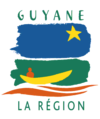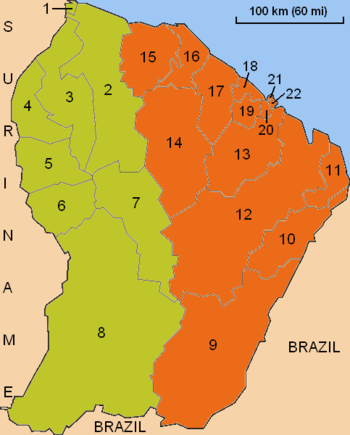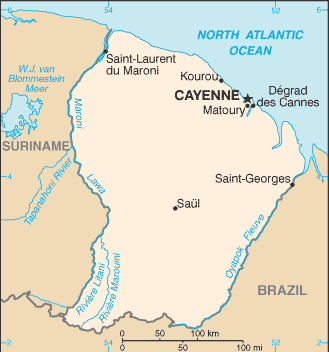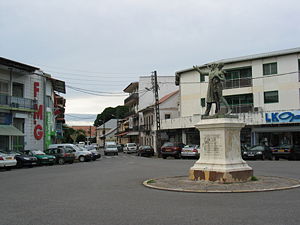French Guiana
2008/9 Schools Wikipedia Selection. Related subjects: Americas; Countries
| Région Guyane | ||
|---|---|---|
|
 |
|
| Region flag | Region logo | |
| Location | ||
|
||
| Administration | ||
| Capital | Cayenne | |
| Regional President | Antoine Karam ( PSG) (since 1992) |
|
| Departments | Guyane | |
| Arrondissements | 2 | |
| Cantons | 19 | |
| Communes | 22 | |
| Statistics | ||
| Land area1 | 83,534 km² | |
| Population | (Ranked 26th) | |
| - January 1, 2007 est. | 209,000 | |
| - March 8, 1999 census | 157,213 | |
| - Density (2007) | 2.5/km² | |
| 1 French Land Register data, which exclude lakes, ponds, and glaciers larger than 1 km² (0.386 sq. mi. or 247 acres) as well as the estuaries of rivers |
||
French Guiana (French: Guyane française, officially Guyane) is an overseas department (French: département d'outre-mer, or DOM) of France, located on the northern coast of South America. Like the other DOMs, French Guiana is also an overseas region of France, one of the 26 regions of France. It is an integral part of France, and its currency is the euro.
History
French Guiana was originally inhabited by a number of indigenous American peoples. Settled by the French during the 17th century, it was the site of penal settlements from 1852 until 1951, which were known in the English-speaking world as Devil's Island. A border dispute with Brazil arose in the late nineteenth century over a vast area of jungle, leading to the short-lived pro-French independent state of Counani in the disputed territory and some fighting between settlers, before the dispute was resolved largely in favour of Brazil by the arbitration of the Swiss government. In 1946, French Guiana became an overseas department of France. The 1970s saw the settlement of Hmong refugees from Laos. A movement for increased autonomy from France gained momentum in the 1970s and 1980s. Protests by those calling for more autonomy have become increasingly vocal; demonstrations in 1996, 1997 and 2000 all ended in violence.
Politics
French Guiana, as part of France, is part of the European Union, the largest part in an area outside Europe, with one of the longest EU external boundaries. Along with the Spanish enclaves in Africa of Ceuta and Melilla, it is one of only three European Union territories outside Europe that are not an island. Its head of state is the President of the French Republic, who appoints a Prefect (resident at the Prefecture building in Cayenne) as his representative. There are two legislative bodies: the 19-member General Council and the 34-member Regional Council, both elected.
French Guiana sends two deputies to the French National Assembly, one representing the commune (municipality) of Cayenne and the commune of Macouria, and the other representing the rest of French Guiana. This latter constituency is the largest in the French Republic by land area. French Guiana also sends one senator to the French Senate.
French Guiana has traditionally been conservative, though the socialist party has been increasingly successful in recent years. Though many would like to see more autonomy for the region, support for complete independence is very low.
A chronic issue affecting French Guiana is the influx of illegal immigrants and clandestine gold prospectors from Brazil and Suriname. The border between the department and Suriname is formed by the Maroni River, which flows through rain forest and is difficult for the Gendarmerie and the French Foreign Legion to patrol. The border line with Suriname is disputed.
Administrative divisions
French Guiana is divided into 2 departmental arrondissements, 19 cantons (not shown here), and 22 communes:
| Arrondissement of Saint-Laurent-du-Maroni |
Arrondissement of Cayenne |
|---|---|
|
|
See also:
- Arrondissements of Guyane (French Guiana)
- Cantons of Guyane (French Guiana)
- Communes of Guyane (Cities of French Guiana)
Geography
Though sharing cultural affinities with the French-speaking territories of the Caribbean, French Guiana cannot be considered to be part of that geographic region, with the Caribbean Sea actually being located several hundred kilometres to the west, beyond the arc of the Lesser Antilles.
French Guiana consists of two main geographical regions: a coastal strip where the majority of the people live, and dense, near-inaccessible rainforest which gradually rises to the modest peaks of the Tumac-Humac mountains along the Brazilian frontier. French Guiana's highest peak is Bellevue de l'Inini (851 m). Other mountains include Mont Machalou (782 m), Pic Coudreau (711 m) and Mont St Marcel (635 m), Mont Favard (200 m) and Montagne du Mahury (156 m). Several small islands are found off the coast, the three Iles du Salut Salvation Islands which includes Devil's Island and the isolated Iles du Connétable bird sanctuary further along the coast towards Brazil.
The Barrage de Petit-Saut hydroelectric dam in the north of French Guiana forms an artificial lake and provides hydroelectricity. There are many rivers in French Guiana.
Economy
French Guiana is heavily dependent on France for subsidies, trade, and goods. The main industries are fishing (accounting for three-quarters of foreign exports), gold mining and timber. In addition, the Guiana Space Centre at Kourou accounts for 25% of the GDP and employs about 1700 people. There is very little manufacturing, and agriculture is largely undeveloped. Tourism, especially eco-tourism, is growing. Unemployment is a major problem, running at about 20% to 30%.
In 2006 the GDP per capita of French Guiana at market exchange rates, not at PPP, was 13,800 euros (US$17,336), which was 48% of Metropolitan France's average GDP per capita that year.
Transport
French Guiana's main international airport is Cayenne-Rochambeau Airport, located in the commune of Matoury, a southern suburb of Cayenne. There is one flight a day to Paris ( Orly Airport), and one flight a day arriving from Paris. The flight time from Cayenne to Paris is 8 hours and 25 minutes, and from Paris to Cayenne it is 9 hours and 10 minutes. There are also flights to Fort-de-France, Pointe-à-Pitre, Port-au-Prince, Miami, Macapá, Belém, and Fortaleza.
French Guiana's main seaport is the port of Dégrad des Cannes, located on the estuary of the Mahury River, in the commune of Remire-Montjoly, a south-eastern suburb of Cayenne. Almost all of French Guiana's imports and exports pass through the port of Dégrad des Cannes. Built in 1969, it replaced the old harbour of Cayenne which was congested and couldn't cope with modern traffic.
An asphalted road from Régina to Saint-Georges de l'Oyapock (a town by the Brazilian border) was opened in 2004, completing the road from Cayenne to the Brazilian border. It is now possible to drive on a fully paved road from Saint-Laurent-du-Maroni on the Surinamese border to Saint-Georges de l'Oyapock on the Brazilian border. Following an international treaty between France and Brazil signed in July 2005, a bridge over the Oyapock River (marking the border with Brazil) is currently being built and is due to open in 2010. This bridge will be the first land crossing ever opened between France and Brazil, and indeed between French Guiana and the rest of the world (there exists no other bridge crossing the Oyapock River, and no bridge crossing the Maroni River marking the border with Suriname - there is a ferry crossing to Albina, Suriname.). When the bridge is opened, it will be possible to drive uninterrupted from Cayenne to Macapá, the capital of the state of Amapá in Brazil.
Demographics
French Guiana's population of 209,000 (January 2007 est.), most of whom live along the coast, is very ethnically diverse. At the 1999 census, 54.4% of the inhabitants of French Guiana were born in French Guiana, 11.8% were born in Metropolitan France, 5.2% were born in the French Caribbean départements (Guadeloupe and Martinique), and 28.6% were born in foreign countries (primarily Brazil, Suriname, and Haiti).
Estimates of the percentages of French Guiana ethnic composition vary, a situation compounded by the large numbers of immigrants (about 20,000).
Guianese Creoles (people of primarily African heritage mixed with some French ancestry) are the largest ethnic group, though estimates vary as to the exact percentage, depending upon whether the large Haitian community is included as well. Generally the Creole population is judged at about 60% to 70% of the total population with Haitians (comprising roughly one-third of Creoles) and 30% to 50% without. Roughly 14% are Europeans, the vast majority of whom are French.
The main Asian communities are the Hmong from Laos (1.5%) and Chinese (3.2%, primarily from Hong Kong and Zhejiang province). There are also smaller groups from various Caribbean islands, mainly Saint Lucia. The main groups living in the interior are the Maroons (also called Bush Negroes) and Amerindians.
The Maroons, descendants of escaped African slaves, live primarily along the Maroni River. The main Maroon groups are the Paramacca, Aucan (both of whom also live in Suriname) and the Boni (Aluku).
The main Amerindian groups (forming about 3%-4% of the population) are the Arawak, Carib, Emerillon, Galibi (now called the Kaliña), Palikour, Wayampi and Wayana.
The most practised religion in this region is Roman Catholicism; the Maroons and some Amerindian peoples maintain their own religions. The Hmong people are also mainly Catholic owing to the influence of Catholic missionaries who helped bring them to French Guiana. The Bahá'í Religion is also present.
| 1790 estimate |
1839 estimate |
1857 estimate |
1891 estimate |
1946 census |
1954 census |
1961 census |
1967 census |
1974 census |
1982 census |
1990 census |
1999 census |
2007 estimate |
|---|---|---|---|---|---|---|---|---|---|---|---|---|
| 14,520 | 20,940 | 25,561 | 33,500 | 25,499 | 27,863 | 33,505 | 44,392 | 55,125 | 73,022 | 114,678 | 157,213 | 209,000 |
| Official figures from past censuses and INSEE estimates. | ||||||||||||
Notable natives and residents
- Florent Malouda, French international football player who plays for Chelsea Football Club
- Henri Charrière, an escaped French convict, imprisoned in and around French Guiana from 1933 to 1945.
- Christiane Taubira, Politician of Parti Radical de Gauche (France)
- Malia Metella, French swimmer, SC European Championships 2004: 1st 100m free.
- Bernard Lama, former French international football player.
- Cyrille Regis, former West Bromwich Albion and England player.
- Léon Damas, Francophone poet widely notated for his influence on the literary movement known as la négritude
- Henri Salvador, famous singer, one of the inspiration sources for the Bossa nova movement.
- Jean-Claude Darcheville, football striker who joined Rangers from FC Girondins de Bordeaux in the summer of 2007.
- Marc-Antoine Fortuné, football striker who joined AS Nancy in the winter of 2006




